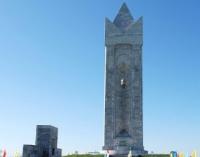You are here
Historical and Cultural Reserve "Ordabasy".




City Tours Shymkent - Almaty.
“Any boundaries are historical”
Paul Ricoeur.
Day Trips in Shymkent.
The historical and cultural national reserve "Ordabasy". Organized on January 1, 1994, on the left bank of the Badam River, 40 kilometers west of Chimkent. Rock paintings and ancient burial mounds were discovered here.
A 28-meter-long stele has been established in the reserve, perpetuating the unity of the three Kazakh zhuzes that occurred in 1729. There is also a tribune where, in 1993, the presidents of Kazakhstan, Kyrgyzstan, and Uzbekistan signed an agreement on eternal friendship.
The historical and cultural national reserve “Ordabasy” is located on the left floodplain terrace of the Badam River. The reserve area is 1134 hectares. The highest point of Ordabasy - Tu-tobe is located at an altitude of 530 meters above sea level.
The annual funding of the reserve is 4 million tenge. 25 employees work here, including one doctor and one candidate of historical sciences. Up to 40,000 people visit the reserve annually. On the territory of the reserve-museum there are 10 monuments of historical and cultural significance.
The total area of the cultural reserve is 1134 ha. Scientists who conducted research here discovered cave paintings and a complex of ancient mounds, all of these objects are also included in the reserve. There is also a tribune where, in 1993, the presidents of Kazakhstan, Uzbekistan and Kyrgyzstan signed an agreement on eternal friendship.
Near the central entrance to the reserve there is a small building in the form of a pyramid, here is a museum. The basis of the museum’s exposition is composed of interesting archaeological artifacts found in the reserve, which have been actively used since ancient times.
Particular attention is drawn to: the well-preserved Saki sword Akinak, a brick with a Nestorian cross, as well as detailed maps illustrating the course of the Kazakh-Dzungarian war. In total, there are 1376 exhibits in the collections and expositions of the museum.
The Dzungar invasion of 1723-1725 in Kazakh history was called "Aktaban Shubyrynda" - it was a time of deprivation and years of wandering. In 1726, in late autumn, on the left bank of the valley of the Badam River, a tributary of Arys, representatives of all three Kazakh zhuzes gathered on the great kurultai.
It was here that on Ordabasy, numerous Kazakh tribes that were fragmented came together, overcoming all differences to confront the most powerful and dangerous invader, the Dzungars. This place must have been marked as a historical, cultural and spiritual attraction of the Kazakh people.
Monument "Birlik".
On the top of Mount Tu-Tobe stands the Birlik stela 28 meters high, as a reminder to the descendants of those heroic years. The Birlik monument (unity) is a monumental structure consisting of three pylons personifying the images of three historical figures Tole, Kazybek, Aiteke.
The diameter of the circumference of the lower part is 8 meters. The trihedral stele is faced with slabs of white marble. Each face is directed to one of the sides of Kazakhstan: towards the Syr Darya - in the west, the Karatau mountains - in the north, Kazygurt mountains - in the southeast.
On each side of the stele there are signs with the sayings of the three great biys. The memorial was erected in 2001 in the year of the 275th anniversary of the famous kuryltai and in the year of the 10th anniversary of independent Kazakhstan. The authors of the complex were the sculptor, A. Mamyrbaev and the architect G. Sadyrbaev.
Small stele of "Ordabasy".
The small stele, established in 1997, personifies the role of Ordabasy in the unity of the Kazakh people. On the front side are written the words of N. Nazarbayev, from a speech in 1993 in the mountains of Ordabasy. The small stele "Ordabasy" is a monumental erected lined with marble slabs.
The total length of the lower pedestal is 7.4 meters, height 1.6 meters. The height of the central part of the stele is 3 meters. In the center of the small stele is a marble slab measuring 90 x 105 cm.
Saki mounds at the complex "Ordabasy."
Ancient Saki mounds date back to the Vth - VIth centuries BC. According to the archaeological detachment of the Turkestan region under the leadership of A.S. Podushkin, there are burials of Saki nobles. Saki mounds are located in the southeast, 3 kilometers from the entrance gate of the Ordabasy Nature Reserve.
The total number of mounds is 8. A memorial stone was erected on one of them in 1993. Height - 0.6 - 1 meter, diameter 7 - 8 meters.
Hill of Unity "Ordabasy".
During a historical meeting on a hill in the distant 1726, as the historical data say, the sarbases called up for war brought along a handful of their native land. According to that legend, out of many handfuls, the “Hill of Unity” “Bіrlіktөbe” turned out.
The hill is located in the southeast of the main entrance to the Ordabasy Nature Reserve. The height of the hill is 14 meters, the diameter of the base is 75 - 80 meters, located at an altitude of 530 meters above sea level.
The altar of "Ordabasy".
The place is lined with stones. The ancient Türkic tribe “Tugu” performed a sacrificial ritual in the form of an animal sacrifice in honor of the deceased tribesman. The remains of this animal were burned at the stake near the altar, and the ashes were buried there.
The total area of the altar is 2.3 × 2.5 meters, height 30 - 70 cm.
Authority and photos:
http://iqap.kz/







